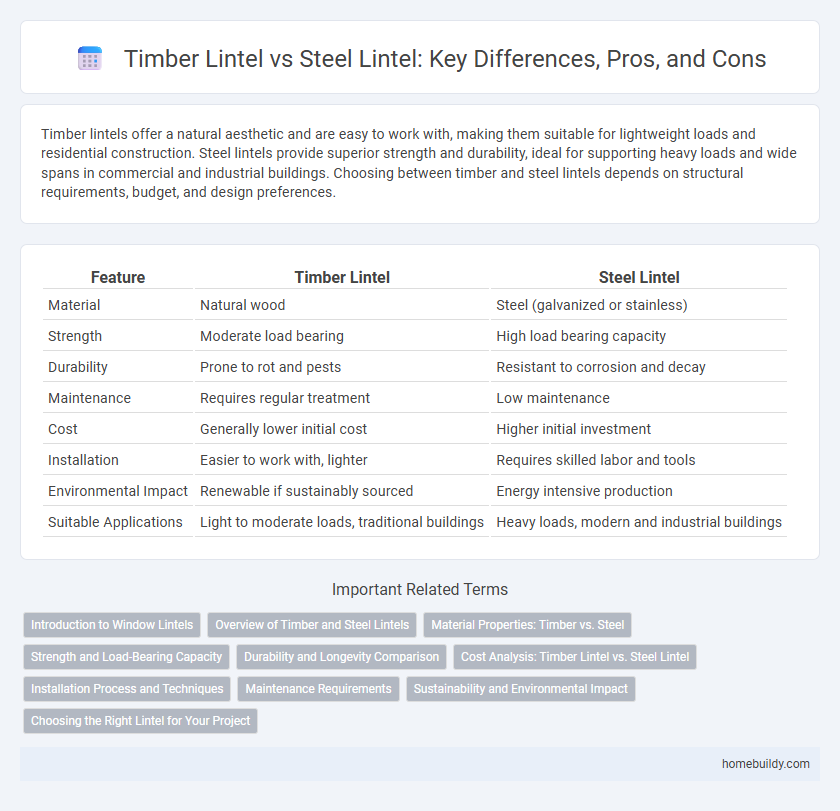Timber lintels offer a natural aesthetic and are easy to work with, making them suitable for lightweight loads and residential construction. Steel lintels provide superior strength and durability, ideal for supporting heavy loads and wide spans in commercial and industrial buildings. Choosing between timber and steel lintels depends on structural requirements, budget, and design preferences.
Table of Comparison
| Feature | Timber Lintel | Steel Lintel |
|---|---|---|
| Material | Natural wood | Steel (galvanized or stainless) |
| Strength | Moderate load bearing | High load bearing capacity |
| Durability | Prone to rot and pests | Resistant to corrosion and decay |
| Maintenance | Requires regular treatment | Low maintenance |
| Cost | Generally lower initial cost | Higher initial investment |
| Installation | Easier to work with, lighter | Requires skilled labor and tools |
| Environmental Impact | Renewable if sustainably sourced | Energy intensive production |
| Suitable Applications | Light to moderate loads, traditional buildings | Heavy loads, modern and industrial buildings |
Introduction to Window Lintels
Window lintels serve as essential horizontal supports above openings, distributing weight and preventing structural damage. Timber lintels offer natural insulation and aesthetic appeal but may be prone to decay and limited load capacity. Steel lintels provide superior strength, durability, and resistance to environmental stress, making them ideal for heavy loads and modern construction demands.
Overview of Timber and Steel Lintels
Timber lintels, made from durable wood, provide excellent load-bearing support for window openings in residential construction, offering natural insulation and aesthetic appeal. Steel lintels, constructed from galvanized or stainless steel, deliver superior strength and resistance to bending under heavy loads, making them ideal for larger spans and commercial applications. Both timber and steel lintels must meet specific building code standards to ensure structural integrity and safety in load distribution.
Material Properties: Timber vs. Steel
Timber lintels offer natural thermal insulation and are lightweight, but they have lower tensile strength and susceptibility to moisture-induced decay compared to steel lintels. Steel lintels provide superior load-bearing capacity, durability, and resistance to environmental factors, making them ideal for supporting heavy masonry loads. The choice between timber and steel lintels depends on structural requirements, environmental exposure, and longevity considerations.
Strength and Load-Bearing Capacity
Timber lintels offer moderate strength and are suitable for light to medium load-bearing applications in residential construction, but their capacity diminishes over time due to susceptibility to moisture and pests. Steel lintels provide superior strength and higher load-bearing capacity, making them ideal for supporting heavier loads in commercial and multi-story buildings while maintaining durability and resistance to environmental factors. Structural engineers often prefer steel lintels in scenarios demanding robust support and long-term stability.
Durability and Longevity Comparison
Timber lintels typically offer moderate durability but are prone to rot, insect damage, and warping over time, especially in damp environments, which can significantly reduce their lifespan. Steel lintels provide superior durability and longevity, resisting corrosion and structural deformation when properly treated or galvanized, often lasting several decades with minimal maintenance. Choosing steel lintels ensures enhanced structural integrity for openings exposed to heavy loads or harsh weather conditions.
Cost Analysis: Timber Lintel vs. Steel Lintel
Timber lintels generally offer a lower upfront cost compared to steel lintels, making them a budget-friendly option for residential projects. Steel lintels, while more expensive initially, provide superior strength and durability, which can reduce long-term maintenance and replacement expenses. When factoring in lifespan and resilience to environmental factors, steel lintels often present better overall value despite the higher initial investment.
Installation Process and Techniques
Timber lintels require precise carpentry skills for cutting and shaping, often installed with nails or screws and must be properly treated to resist moisture and pests, ensuring structural integrity. Steel lintels, typically prefabricated and heavier, demand lifting equipment for placement and are secured using bolts or metal connectors, providing enhanced load-bearing capacity and fire resistance. Installation of steel lintels often involves anchoring into masonry with grout or mortar to ensure stability and durability in supporting window openings.
Maintenance Requirements
Timber lintels require regular maintenance such as painting or sealing to prevent rot, insect infestation, and moisture damage, ensuring durability and structural integrity. Steel lintels demand less frequent upkeep but need periodic inspection for corrosion, especially in humid or coastal environments, and may require protective coatings to avoid rust. Overall, steel lintels offer lower maintenance requirements compared to timber, making them a more durable option in harsh weather conditions.
Sustainability and Environmental Impact
Timber lintels offer a renewable resource with lower embodied energy and carbon footprint compared to steel lintels, making them more sustainable for eco-conscious construction. Steel lintels, while durable and recyclable, require intensive mining and manufacturing processes that contribute significantly to greenhouse gas emissions. Choosing timber lintels supports carbon sequestration and reduces overall environmental impact in building projects.
Choosing the Right Lintel for Your Project
Timber lintels offer natural insulation and aesthetic appeal but are limited in load-bearing capacity and prone to moisture damage, making them suitable for light structures and interior openings. Steel lintels provide superior strength, durability, and resistance to environmental factors, ideal for supporting heavy loads in commercial and multi-story buildings. Selecting the right lintel requires assessing structural demands, environmental exposure, and budget constraints to ensure long-term performance and safety.
timber lintel vs steel lintel Infographic

 homebuildy.com
homebuildy.com